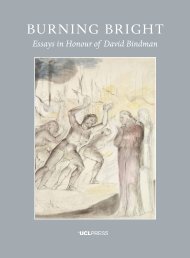Archives
TiL0x
TiL0x
You also want an ePaper? Increase the reach of your titles
YUMPU automatically turns print PDFs into web optimized ePapers that Google loves.
was only so far, given university politics, that such influential lobbying<br />
could take a candidate. The new foreign king was roundly rebuffed<br />
by the Fellows, who chose another candidate. Nevertheless, Newton’s<br />
public career was clearly in the ascendent, thanks in no small part to<br />
the brothers Huygens. 26<br />
Even though this direct attempt by Christiaan Huygens to advance<br />
Newton’s career proved unsuccessful, it significantly strengthened the<br />
relationship between the two men, and with it the intensity of the intellectual<br />
bond between them. In August, before Christiaan returned home,<br />
Newton presented him with two papers on motion through a resisting<br />
medium, in response to his Discours de la cause de la Pesanteur. Autograph<br />
copies of these papers (marked ‘received in London, August 1690’ by<br />
Huygens), and Huygens’s notes in response, survive. The two men also<br />
had lengthy discussions of optics and colour. Huygens told Leibniz that<br />
Newton had communicated ‘some very beautiful experiments’ to him –<br />
probably his experiments with thin films similar to the ones Huygens<br />
himself had performed twenty years earlier, and similar to those Robert<br />
Hooke had recorded in his Micrographia even earlier. 27<br />
In the domain of science and virtuosity, Christiaan did not confine<br />
himself to constructing a solid relationship with Newton. In pursuit<br />
of his general aim of re-establishing his connections with the London<br />
scientific virtuosi, he did indeed see Robert Boyle, and was shown<br />
experiments that delighted him in the field of what we would call<br />
chemistry, but in the period was actually closer to alchemy:<br />
Saw Mr Boyle 3 times. On the last occasion he showed us an<br />
experiment with two cold liquids which burst into flame when<br />
they were combined. He had moistened a piece of wool in a silver<br />
spoon with the first, which had a strong smell almost like oil of<br />
anis. The other, which was poured on to it, was in a tiny vial, and<br />
gave off fumes when the stopper was removed. 28<br />
26 R. S. Westfall, Never at Rest: A Biography of Isaac Newton (Cambridge: Cambridge<br />
University Press, 1983), p. 480.<br />
27 Westfall, Never at Rest, p. 488.<br />
28 ‘Vu Mr. Boile 3 fois. A la derniere il nous fit voir l’experience de deux liqueurs froides qui<br />
estant mises ensemble faisoient une flame. De l’une, qui avoit une senteur forte presque<br />
comme de l’huile d’anis, il avoit mouillè de la laine dans une ceuillere d’argent. L’autre<br />
qu’on versa dessus estoit dans une tres petite phiole, et fumoit quand on ostoit le couvercle’<br />
(Huygens, Oeuvres Complètes 22, 746). See also his farewell to Boyle: ‘19 Aug. Pris congè de<br />
Mr Boijle, de Mr. Fatio, et Mr. Locke. De Mr. Witsen et chez Me. P. f. le f. Mr. Boijle me promit<br />
la recepte pour faire de la glace sans glace ni neige’ (Huygens, Oeuvres Complètes 22, 747).<br />
Boyle finally sent the recipe in April 1690, after several reminders via Constantijn.<br />
Huygens, Oeuvres Complètes 9, 407; Huygens, Oeuvres Complètes 19, 684.<br />
30 TEMPTATION IN THE ARCHIVES





